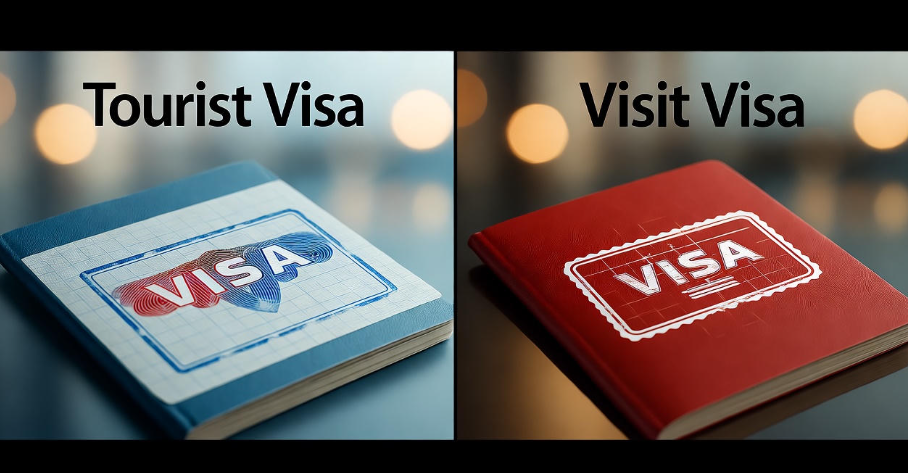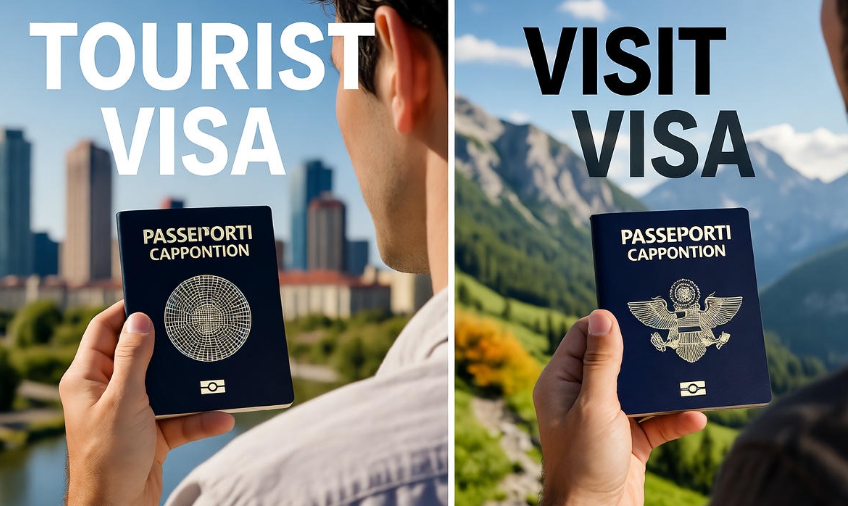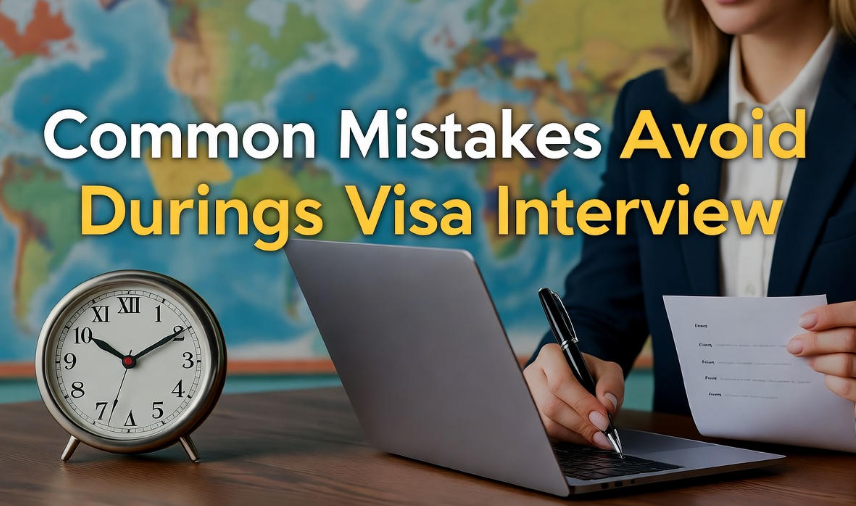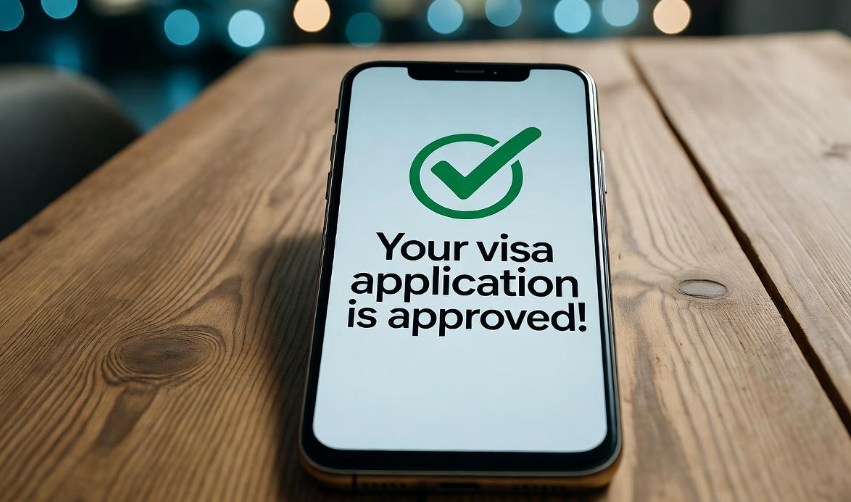Traveling abroad is one of the most exciting things a person can experience . Whether you are going for a short vacation or visiting your family and friends in another country, you’ll definitely need a visa. But here’s where things often get confusing — many people can’t clearly tell the difference between a tourist visa and a visit visa. Both allow you to enter a country for a limited time, but they serve different purposes. Understanding this difference can save you from visa rejections, legal troubles, and wasted money.
Let’s talk about it in very simple words, so you can understand which visa is right for you.
What is a Tourist Visa?
A tourist visa is a type of visa that allows you to travel to a country purely for recreation, sightseeing, or leisure. You’re not allowed to work, study, or do any business activities while you’re on this visa. Think of it like a “holiday pass” — it lets you enjoy the culture, nature, food, and attractions of another country without getting involved in any work.
For example, if you want to go to Paris to see the Eiffel Tower , explore the museums, or take pictures with croissants in your hand — you’ll need a tourist visa.
Most countries issue tourist visas for short durations, usually ranging from 15 days to 6 months, depending on the country’s rules.
Here’s a simple table to make it clear:
| Purpose | Tourist Visa |
|---|---|
| Main Reason for Travel | Leisure, vacation, sightseeing |
| Allowed Activities | Tourism, shopping, attending festivals |
| Stay Duration | Short-term (usually 15 days to 6 months) |
| Work Permission | ❌ Not allowed |
| Extension Possibility | Rarely allowed |
| Common Countries | USA, UK, Canada, UAE, Schengen states, etc. |
What is a Visit Visa?
Now, a visit visa is slightly different. It’s meant for people who want to travel to another country to meet relatives, family members, or friends. Sometimes, it can also be used for business visits, medical purposes, or short-term educational trips — depending on the country’s specific visa rules.
Let’s say your brother lives in Dubai, and he invites you to spend a few weeks with his family. In this case, you would apply for a visit visa, not a tourist visa.
A visit visa usually involves an invitation letter from the person or organization you are visiting. It’s also often sponsored — meaning your host might need to prove they can support you financially during your stay.
| Purpose | Visit Visa |
|---|---|
| Main Reason for Travel | Visiting family, friends, or business associates |
| Allowed Activities | Attending family events, business meetings, or short training sessions |
| Stay Duration | Short to medium term (1 month to 1 year, varies) |
| Work Permission | ❌ Not allowed (except in business meetings) |
| Extension Possibility | Often possible (with valid reason) |
| Common Countries | UK, Canada, UAE, Australia, USA, etc. |
The Main Difference Between Tourist and Visit Visa
Both visas look similar on the surface — but their purpose, sponsorship requirements, and permissions make them different.
Let’s simplify it with a detailed comparison:
| Category | Tourist Visa | Visit Visa |
|---|---|---|
| Purpose | Travel for fun, leisure, or tourism | Visit family, friends, or attend meetings |
| Invitation Letter | Not required | Usually required |
| Sponsor Requirement | No sponsor needed | Often needs a local sponsor/relative |
| Allowed Stay Duration | Short (few weeks to few months) | Can be longer (up to 1 year in some cases) |
| Extension Option | Rare | More flexible depending on situation |
| Eligibility | Anyone planning for leisure travel | People with family/friends in destination country |
| Documentation | Basic travel documents (hotel booking, return ticket) | Extra documents like invitation letter, proof of relationship |
| Work/Business Permission | Not allowed | Limited (like attending meetings, not working) |
| Cost | Usually cheaper | Often a bit more expensive due to extra verification |
Which One Should You Apply For?
Choosing between the two depends entirely on why you are traveling.
If you’re just going on vacation — apply for a tourist visa.
If you’re visiting family or friends who live abroad — go for a visit visa.
If you’re attending a wedding, graduation, or a business meeting — a visit visa is more suitable.
Remember: Applying for the wrong visa type can lead to rejection. Many visa officers reject applications when your reason for travel doesn’t match the visa type you applied for.
So before you apply, ask yourself: Am I going for fun or to visit someone? — and that will tell you the right choice.
Common Mistakes People Make When Applying
People often make small mistakes that cause big delays or even rejection. Here are some to avoid:
-
Applying for the wrong visa type – For example, saying you’re visiting family on a tourist visa.
-
Not showing proper financial proof – Both visas need proof that you can afford your stay.
-
Missing invitation letter (for visit visa) – This is one of the most common reasons for rejection.
-
No return ticket or hotel booking (for tourist visa) – It shows weak travel intent.
-
Overstaying previous visa – If you stayed longer than your previous visa allowed, future applications can be affected.
How to Apply for Each Visa
The process for both visas is quite similar, but the documents and purpose differ slightly.
| Step | Tourist Visa Process | Visit Visa Process |
|---|---|---|
| 1. Fill Application Form | Online or paper form | Online or paper form |
| 2. Attach Documents | Passport, travel plan, bank statement, hotel booking | Passport, invitation letter, sponsor’s ID, relationship proof |
| 3. Pay Fees | Online or via bank | Online or via bank |
| 4. Schedule Appointment | Embassy or visa center | Embassy or visa center |
| 5. Attend Interview | Usually short, about travel plan | More detailed, about host and relationship |
| 6. Wait for Approval | 5–20 days (varies by country) | 10–30 days (depends on sponsor verification) |
Pro Tip: Always apply early — at least 4 to 6 weeks before your planned trip — because visa processing times can change unexpectedly.
What Happens If You Violate Visa Rules?
This is very important to understand ⚠️. Both visas come with conditions, and if you break them, it can lead to serious consequences.
For instance, if you go on a tourist visa and start doing business or working — that’s illegal. You could get fined, deported, or even banned from entering that country again.
Similarly, on a visit visa, you can’t work unless your visa specifically allows limited business meetings. Always read the visa terms printed on your visa sticker or letter before traveling.
| Violation Example | Possible Consequence |
|---|---|
| Working on a tourist visa | Immediate deportation |
| Overstaying visa duration | Heavy fines or entry ban |
| Using fake documents | Permanent ban |
| Mismatched purpose (applying for tourist visa to visit family) | Visa rejection or denial of entry |

Benefits of Tourist Visa
-
Easier to apply (no sponsor required)
-
Short processing time ⏱️
-
Great for solo or leisure travelers
-
Can visit multiple destinations (depending on visa type like Schengen)
-
Cheaper and simpler process
Benefits of Visit Visa
-
Allows visiting loved ones abroad ❤️
-
Longer stay possible (in many countries)
-
Can include multiple entries (for business or family visits)
-
Host can support you financially
-
Often considered more flexible than a tourist visa
Can You Convert a Tourist Visa into a Visit Visa?
In most countries, no, you cannot convert a tourist visa into a visit visa once you are inside the country. You usually need to exit and apply for a new visa type from your home country.
However, some countries (like the UAE) allow in-country visa conversion under specific conditions, often by paying a conversion fee. But this rule changes often — so it’s always best to check the latest immigration guidelines.
Duration and Validity Differences
| Country Example | Tourist Visa Validity | Visit Visa Validity |
|---|---|---|
| UAE | 30 to 90 days | 30 to 90 days, extendable |
| USA | Up to 6 months | Up to 6 months, extendable |
| UK | 6 months | 6 months to 2 years (depending on relation) |
| Canada | Up to 6 months | 6 months (with family sponsorship) |
| Australia | 3 to 12 months | 3 to 12 months (based on visit purpose) |
As you can see, the visit visa often allows longer or repeated visits, especially when family ties or sponsorships are involved.
Tips to Get Approved Easily ✅
-
Be Honest in Your Application. Never hide the real purpose of your visit.
-
Provide Strong Proof of Ties to Home Country. Like job letters, family proof, or property documents — to show you’ll return.
-
Keep Documents Neat and Clear. All copies should be readable and up to date.
-
Don’t Overstay Previous Visas. Immigration officers can check your travel history.
-
Show Adequate Funds. Always prove you can afford your stay without working.
Real-Life Example
Let’s imagine two friends — Ali and Ahmed.
-
Ali plans to go to Turkey to explore Istanbul, visit museums, and enjoy his vacation.
-
Ahmed wants to go to Canada to visit his brother who works there.
Ali will apply for a tourist visa, while Ahmed will apply for a visit visa. Both might stay for about a month, but their visa categories are different because their purpose is different. That’s the simplest way to remember it.
Conclusion
In short, the difference between a tourist visa and a visit visa is all about the intention of your travel.
-
If you’re traveling for fun, leisure, or sightseeing, choose a tourist visa.
-
If you’re traveling to meet someone or attend a personal event, apply for a visit visa.
Getting the right visa doesn’t just make your journey smoother — it also keeps you safe from legal issues and makes your travel experience enjoyable and stress-free.
FAQs
1. Can I visit my relatives on a tourist visa?
Technically yes, you can meet them, but if your main purpose is to stay with family, then it’s safer and more correct to apply for a visit visa.
2. Is a visit visa harder to get than a tourist visa?
It depends. Visit visas often need extra documents (like invitation letters), so they might take longer.
3. Can I work while on a visit or tourist visa?
No. Neither visa allows employment. You need a separate work visa for that.
4. Can I extend my stay if I’m enjoying my trip?
Some countries allow short extensions for both types of visas, but you must apply before your current visa expires.
5. What happens if I overstay my visa?
Overstaying can lead to fines, deportation, or even future visa rejections. Always leave before your visa expires.
6. Do I need travel insurance for both visa types?
Yes, in most countries travel insurance is mandatory, and it protects you from medical emergencies abroad.
✨ Traveling is a beautiful experience, and understanding your visa type is the first step toward a stress-free journey. So next time you plan to fly, make sure you choose the right visa — it’s a small decision that makes a big difference.




